Ledebouria burkei subsp. stolonissima
Ledebouria burkei (Baker) J.C.Manning & Goldblatt subsp. stolonissima (U.Müll.-Doblies & D.Müll.-Doblies) J.C.Manning & Goldblatt
Family: Hyacinthaceae
Common names: Lebowa African hyacinth
Introduction
Dwarf bulbous plant with attractively camouflaged leaves, growing in shade amongst leaf litter, with white to green flowers in early spring and summer.
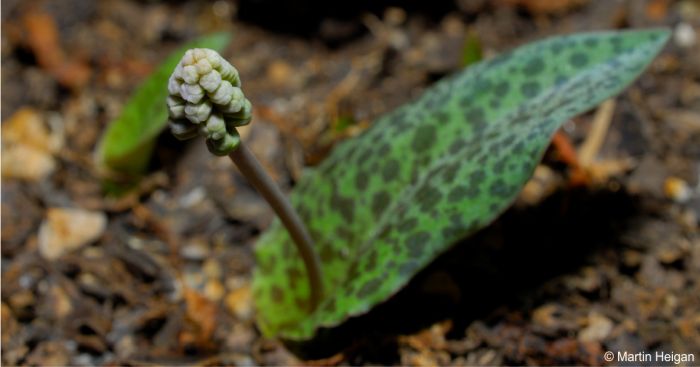
Description
Description
Ledebouria burkei subsp. stolonissima is a dwarf, densely gregarious bulbous plant that grows in shallow humus-rich soil in shady woodland and on rock outcrops and cliffs. Stolons (modified underground stems) spread horizontally from the base of the mother bulbs to establish new plants nearby resulting in dense colonies. Off-whitish, narrowly pear-shaped bulbs reach approximately 30-50 mm in length and 20-30 mm in width. Like all members of the section Drimiopsis, they do not possess a tunic (dry sheath of old bulb scales covering the bulb) which is commonly seen in the section Ledebouria, instead the bulbs are naked with truncated bulb scales. Shortly stalked to stalkless, narrowly lanceolate leaves are produced in summer, usually 2 per bulb, about 100-120 mm long and 25-35 mm wide. Leaves are pale green, usually with darker green spots on the upper surface, they have a matt finish, are slightly dull and completely hairless and may be spreading or close to the ground. Flowers are produced in spring and early summer (September to October). Each bulb usually produces a solitary, elongated inflorescence, which can be up to 150 mm long, initially erect, quite soon leaning, then becoming floppy as the fruit develops. Numerous, loosely arranged, greenish flowers (florets) develop from the terminal white flower buds. Each floret is comprised of 6 tepals (petals), and is attached by a short pedicel (stalk). Typical of the section Drimiopsis, the scented florets do not open significantly, only exposing a small pore through which the pollinator must open the tepals and reach in to obtain the nectar reward. The flowers are followed by swollen green capsules which soon wither to reveal the shiny wrinkled dark brown seeds.
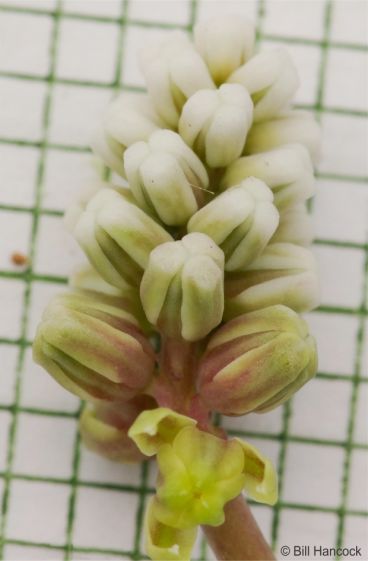
Conservation Status
Status
The Lebowa African hyacinth is listed on the Red List of South African Plants as Critically Rare (CR) due to the species being known from only a single locality. However, it is not threatened because the location where the species grows is very inaccessible and unlikely to be affected by human activity.
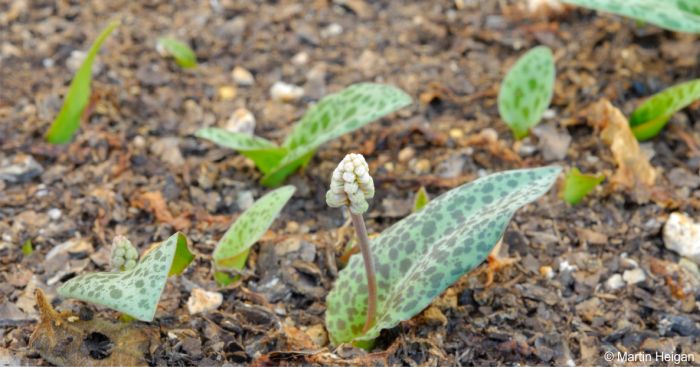
Distribution and habitat
Distribution description
Ledebouria burkei subsp. stolonissima occurs in Ohrigstad Mountain Bushveld in the Limpopo Province of South Africa, where it grows on steep cliffs and rocky outcrops in very inaccessible places in hot river valleys at 900 masl in the Savanna Biome. The species prefers to grow under the sparse canopy of mixed broadleaf woody species amongst the leaf litter often with very little mineral soil and mostly compost and leaf litter. The area experiences hot summers with approximately 645 mm of rain per annum. Maximum summer temperatures can reach 30°C and minimum winter temperatures usually reach around 10°C.
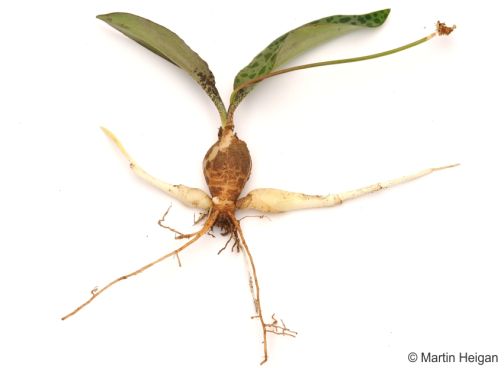
Derivation of name and historical aspects
History
This subspecies was named for the first time in 1997, by the German husband and wife Botanist team Drs Ute and Dietrich Müller-Doblies. The species was originally described as Drimiopsis burkei subsp. stolonissima, however the genus Drimiopsis was subsequently combined into Ledebouria in 2004 by Prof John Manning, who, in 2012, also created two sections in Ledebouria to accommodate the closely allied groups, section Drimiopsis and section Resnova, that were formerly recognised as separate genera, thus the name became Ledebouria burkei subsp. stolonissima.
The genus is named in honour of the German-Estonian botanist, Professor Carl Friedrich von Ledebour (1785–1851). South Africa has 61 species of Ledebouria, with several more species occurring across southern, western, eastern and northeast Africa and into India. The genus Ledebouria is a member of the Hyacinth Family and is well represented especially across the eastern, summer rainfall parts of South Africa. The species is named after the botanist and plant collector Joseph Burke (1812–1873). The subspecific epithet stolonissima is in reference to the fact that this subspecies produces stolons (underground stems) to propagate itself vegetatively and create small colonies.
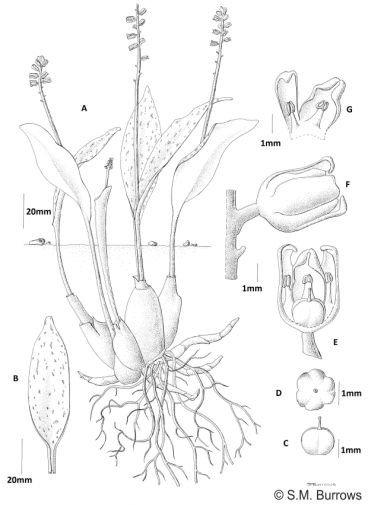
Ecology
Ecology
Ledebouria burkei subsp. stolonissima remains very little known and as such there is no literature making reference to any ecological aspects. However, most plants in this section of the genus, the flowers only open partially, requiring pollinators to physically open the tepals to gain access to the pollen and nectar. This limitation reduces the number of pollinators which are able to pollinate the hyacinth-scented flowers. Mostly small solitary bees and some flies have been observed visiting the flowers. After pollination the swollen, green, seed capsules develop rapidly. The small seeds are released by the bursting and shriveling seed capsule and germinate mostly within close proximity to the adult plant.
Uses
Use
There are no recorded medicinal or cultural uses of this species.
Growing Ledebouria burkei subsp. stolonissima
Grow
The Lebowa African hyacinth is easily cultivated although the species is very rarely seen in cultivation. Due to its stoloniferous nature, it will quickly fill any container that it is planted in. It can be used in hot dry climates as it is well adapted to these environments. However, it is very adaptable and will thrive in many different climates. It can be used in containers to create a ground cover for larger succulent plants such as aloes or euphorbias or it can be planted in the garden amongst rocks where it can be allowed to cover the areas where it grows.
It prefers well drained sandy soil with lots of old dry compost or leaf litter. Fertilising is seldom necessary, but a dilute organic fertilizer will be of benefit. While dormant in winter watering should be withheld completely to allow the soil to dry out. The species can tolerate cold temperatures while dormant providing that the soil medium is kept dry.
The species can be propagated by dividing the bulbs and stolons and planting them up separately in new containers. Seed should be sown immediately in trays or pots in a loose well-drained sifted seedling mixture, seeds should be covered 3mm with the sifted soil mixture mentioned above. Seeds usually germinate within 3-6 weeks and can remain in the seedling containers for the first year or until the seedlings are large enough to handle.
References
- Hankey, A.J. 2019. Proposed English common names for African hyacinths (genus Ledebouria). Plantlife SA Vol 47:7. https://plantlifesouthafrica.blogspot.com/
- Hankey, A.J. 2021. Ledebouria burkei (Baker) J.C.Manning & Goldblatt subsp. burkei (Hyacinthaceae). PlantZAfrica. Online. http://pza.sanbi.org/ledebouria-burkei-subsp-burkei.
- Manning, J.C. & Goldblatt, P. 2012. Hyacinthaceae. New combinations in Ledebouria. Bothalia 42 (1): 47–48.
- Manning, J.C., Goldblatt, P. & Fay, M.F. 2004. A revised generic synopsis of Hyacinthaceae in sub-Saharan Africa, based on molecular evidence, including new combinations and the new tribe Pseudoprospereae. Edinburgh Journal of Botany 60: 533–568.
- Mucina, L. & Rutherford, M.C. (eds) 2006. The vegetation of South Africa, Lesotho and Swaziland. Strelitzia 19. South African National Biodiversity Institute, Pretoria.
- Müller-Doblies, U. & Müller-Doblies, D. 1997. A partial revision of the tribe Massonieae (Hyacinthaceae). Feddes Repertorium 108 (1–-2): 49–96.
- Victor, J.E. & Hankey, A.J. 2011. Ledebouria burkei (Baker) J.C.Manning & Goldblatt subsp. stolonissima (U.Müll.-Doblies & D.Müll.-Doblies) J.C.Manning & Goldblatt. National Assessment: Red List of South African Plants version. Accessed on 2024/03/11.
- Wikipedia. Carl Friedrich von Ledebour. http://en.wikipedia.org/wiki/Carl_Friedrich_von_Ledebour. Accessed 6 November 2018.
Credits
Andrew Hankey
Walter Sisulu National Botanical Garden
April 2024
Acknowledgements: the author thanks Sandie Burrows for the illustration, and Bill Hancock and Martin Heigan for the images.
Plant Attributes:
Plant Type: Bulb
SA Distribution: Limpopo
Soil type: Sandy
Flowering season: Spring
PH: Acid, Neutral
Flower colour: Green, White
Aspect: Shade, Morning Sun (Semi Shade)
Gardening skill: Easy
Special Features:
Horticultural zones











Rate this article
Article well written and informative
Rate this plant
Is this an interesting plant?
Login to add your Comment
Back to topNot registered yet? Click here to register.